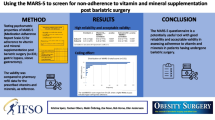Abstract
In order to improve warfarin adherence, we must first know the rate of non-adherence and the reasons for it. Assessment of warfarin adherence is important in improving patients’ warfarin-taking behavior and International Normalized Ratio (INR) control. This study aimed to compare three medication adherence measures in patients taking warfarin: the 8-item Morisky Medication Adherence Scale (MMAS), the 100-point Visual Analogue Scale (VAS) and medication refill adherence (MRA). A cross-sectional observational study was conducted in a convenience sample of 174 patients taking warfarin at an anticoagulation clinic. A survey questionnaire that included the MMAS, VAS, and demographic and warfarin-related clinical questions was administered to patients in English or Chinese depending on their preferences. The MRA and INR values were retrieved from hospital electronic databases. Most participants were adherent to warfarin as indicated by the three measures. A weak association was found between the MMAS and the other two adherence measures. The MMAS and MRA were associated with the percentage of INRs within range in the past 2 weeks. Moreover, the MRA was weakly associated with time within the therapeutic INR range in the past 3 months and 2 weeks. The findings provide insights into the differences among three medication adherence measures and may assist healthcare providers to select the most suitable measure for the assessment of warfarin adherence.

Similar content being viewed by others
References
Ansell J, Hirsh J, Poller L, Bussey H, Jacobson A, Hylek E (2004) The pharmacology and management of the vitamin K antagonists: the seventh ACCP conference on antithrombotic and thrombolytic therapy. Chest 126:204S–233S
Levine MN, Raskob G, Beyth RJ, Kearon C, Schulman S (2004) Hemorrhagic complications of anticoagulant treatment: the seventh ACCP conference on antithrombotic and thrombolytic therapy. Chest 126:287S–310S
Merli GJ, Tzanis G (2009) Warfarin: what are the clinical implications of an out-of-range-therapeutic International Normalized Ratio? J Thromb Thrombolysis 27:293–299
Hylek EM, Go AS, Chang Y, Jensvold NG, Henault LE, Selby JV, Singer DE (2003) Effect of intensity of oral anticoagulation on stroke severity and mortality in atrial fibrillation. N Engl J Med 349:1019–1026
Wittkowsky AK, Devine EB (2004) Frequency and causes of overanticoagulation and underanticoagulation in patients treated with warfarin. Pharmacotherapy 24:1311–1316
Waterman AD, Milligan PE, Bayer L, Banet GA, Gatchel SK, Gage BF (2004) Effect of warfarin nonadherence on control of the International Normalized Ratio. Am J Health Syst Pharm 61:1258–1264
Hixson-Wallace JA, Dotson JB, Blakey SA (2001) Effect of regimen complexity on patient satisfaction and compliance with warfarin therapy. Clin Appl Thromb Hemost 7:33–37
Osterberg L, Blaschke T (2005) Adherence to medication. N Engl J Med 353:487–497
Vermeire E, Hearnshaw H, Van Royen P, Denekens J (2001) Patient adherence to treatment: three decades of research. a comprehensive review. J Clin Pharm Ther 26:331–342
Morisky DE, Ang A, Krousel-Wood M, Ward HJ (2008) Predictive validity of a medication adherence measure in an outpatient setting. J Clin Hypertens (Greenwich) 10:348–354
Hess LM, Raebel MA, Conner DA, Malone DC (2006) Measurement of adherence in pharmacy administrative databases: a proposal for standard definitions and preferred measures. Ann Pharmacother 40:1280–1288
Orensky IA, Holdford DA (2005) Predictors of noncompliance with warfarin therapy in an outpatient anticoagulation clinic. Pharmacotherapy 25:1801–1808
Platt AB, Localio AR, Brensinger CM et al (2010) Can we predict daily adherence to warfarin?: results from the International Normalized Ratio adherence and genetics (IN-RANGE) study. Chest 137:883–889
Krousel-Wood M, Islam T, Webber LS, Re RN, Morisky DE, Muntner P (2009) New medication adherence scale versus pharmacy fill rates in seniors with hypertension. Am J Manag Care 15:59–66
Sakthong P, Chabunthom R, Charoenvisuthiwongs R (2009) Psychometric properties of the thai version of the 8-item Morisky medication adherence scale in patients with type 2 diabetes. Ann Pharmacother 43:950–957
Palareti G, Legnani C, Guazzaloca G et al (2005) Risks factors for highly unstable response to oral anticoagulation: a case-control study. Br J Haematol 129:72–78
Al-Qazaz H, Hassali MA, Shafie AA, Sulaiman SA, Sundram S, Morisky DE (2010) The eight-item Morisky medication adherence scale MMAS: translation and validation of the Malaysian version. Diabetes Res Clin Pract 90:216–221
Sweileh WM, Ihbesheh MS, Jarar IS et al (2011) Self-reported medication adherence and treatment satisfaction in patients with epilepsy. Epilepsy Behav 21:301–305
Nau DP, Steinke DT, Williams LK, Austin R, Lafata JE, Divine G, Pladevall M (2007) Adherence analysis using visual analog scale versus claims-based estimation. Ann Pharmacother 41:1792–1797
Bozek A, Jarzab J (2010) Adherence to asthma therapy in elderly patients. J Asthma 47:162–165
Berg KM, Wilson IB, Li X, Arnsten JH (2012) Comparison of antiretroviral adherence questions. AIDS Behav 16:461–468
Choo PW, Rańd CS, Inui TS et al (1999) Validation of patient reports, automated pharmacy records, and pill counts with electronic monitoring of adherence to antihypertensive therapy. Med Care 37:846–857
Zeller A, Ramseier E, Teagtmeyer A, Battegay E (2008) Patients’ self-reported adherence to cardiovascular medication using electronic monitors as comparators. Hypertens Res 31:2037–2043
Acknowledgments
We would like to acknowledge Professor Donald E. Morisky for providing us with the 8-item Morisky Medication Adherence Scale. We also thank Mr. Maung Maung Aung for his assistance in survey data collection and the pharmacists at the anticoagulation clinic of the Singapore General Hospital for patient referrals.
Conflict of interest
Nothing to declare.
Author information
Authors and Affiliations
Corresponding author
Rights and permissions
About this article
Cite this article
Wang, Y., Kong, M.C. & Ko, Y. Comparison of three medication adherence measures in patients taking warfarin. J Thromb Thrombolysis 36, 416–421 (2013). https://doi.org/10.1007/s11239-013-0872-5
Published:
Issue Date:
DOI: https://doi.org/10.1007/s11239-013-0872-5




